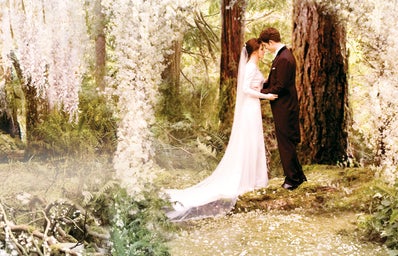All good things must come to an end, even a story about immortal vampires. “Breaking Dawn” is the current conclusion (I mean, you never know if S. Meyer will write another sequel) to the “Twilight Saga.”
SPOILERS LIE PAST THIS POINT
After finally agreeing to Edward’s conditions, Bella is set to marry Edward and finally become a vampire. But, those plans change during the couple’s honeymoon, when Bella becomes pregnant with a half-human, half-vampire baby that is slowly killing her.
Much like her other novels, Meyer’s writing is still mediocre, along with her storytelling. I found “Breaking Dawn” to be the most challenging book to finish in this series due to its length and numerous dull moments. She really didn’t need to waste so much time with Bella dying while carrying Renesmee when she could have developed more of Bella’s beginnings as a vampire or the small family she has created. I also wasn’t a massive fan of the book’s structure.
Like its predecessor, “Breaking Dawn” is mostly told from Bella’s point of view, but Meyer dedicates the middle chunk of the book to Jacob’s perspective. It’s not that I don’t like Jacob (I actually really like him), but I found it logical, and random to see the story through his eyes. Jacob’s perspective explains much of what’s going on while Bella is pregnant, which is good because I would hate to read 200 pages of Bella moaning and griping about her pain. So, there’s a point for the side of logic. Allowing Jacob to tell his story allows for more development of the wolf pack and describes that very controversial imprinting scene (more on that later). More points for logic! But, it felt awkward to return to Bella’s story once Jacob was done. It broke the story’s flow and treated him like the next significant character after Bella, which is not the case. I think this alternative perspective could’ve worked better if Meyer had sprinkled it in other books or established “Breaking Dawn” as multiple perspectives and included others, like, I don’t know, Edward! Once again, I understand why, but that doesn’t mean I like it.
As always, I have to hand it to Meyer. She is one creative individual, which both elevates and hinders her story. In terms of elevation, with Bella becoming a vampire, her dearest wish, Meyer has created a much more likable, more alive character. Renesmee’s addition gives Bella something more to fight for and gives her more substantial characteristics that make for a more compelling and intriguing character. Bella finally has the depth I’ve been begging for! Edward, on the other hand, is just kinda there. I love that vampire, but he spends most of the novel pacing and panicking over the cause of Bella’s stupid actions. Luckily, Meyer’s creativity did not do too much harm to our beloved lovers, but oh, did it harm the werewolf.
“Breaking Dawn” is controversial for one big reason: Jacob imprinting on Renesmee as a baby fresh out of the womb, and I side with the team this didn’t have to happen. First of all, Meyer’s insistence on creating “imprinting” for her supernatural world was ridiculous, to begin with, especially since her description of it is vague, meaningless and explained by “it’s a wolf thing.” Second of all, Jacob’s “choice” of imprint romanticizes predatory behavior. While Jacob constantly insists that he feels nothing romantic toward Renesmee yet, the fact that he hangs around her and is so fascinated with her is plain creepy. I get that Meyer had to come up with some way to keep Jacob in Bella’s life, but there were so many other ways. Imprinting is just another example of how Meyer completely wrecked Jacob Black, a character with so much potential but trapped in the hands of an incapable author.
Considering how large and epic this last book was, the film creatives split “Breaking Dawn” into two parts. Both parts were directed by Bill Condon (2017’s “Beauty and the Beast”) and man, does he just get “Twilight.” Condon’s direction, much like “Eclipse,” is a breath of fresh air for the franchise. Both parts draw from earlier installments, like music and visuals, but understand the balance between the love story and impending doom Bella and Edward always find themselves in. This comes in full force with “Part Two’s” climactic action sequence. Even though it puts so many of our beloved characters in harm’s way, it’s probably one of my favorite moments from the saga because it kept me on edge and is so well executed. Rosenberg also seems to finally conjure up a good screenplay that is believable, given the supernatural elements, and keeps our characters true to their form. So, “Breaking Dawn” as a book was not my favorite, but “Part Two” is the best the movies have to offer and is probably my favorite movie.
And there it is. The end of my journey with “The Twilight Saga.” Overall, I really enjoyed myself. Are the books and movies the best things out there? Heck no! But, did I get a bit teary-eyed watching the credits of “Breaking Dawn: Part 2?” Oh yes, I did! So, I’ll admit it. “Twilight” is trash. There are so many better book adaptations out there. But, it’s that enjoyable trash that you can’t look away from. The kind that makes your face light up and heart go pitter-patter. It is pure trash, but it is my kind of trash.



